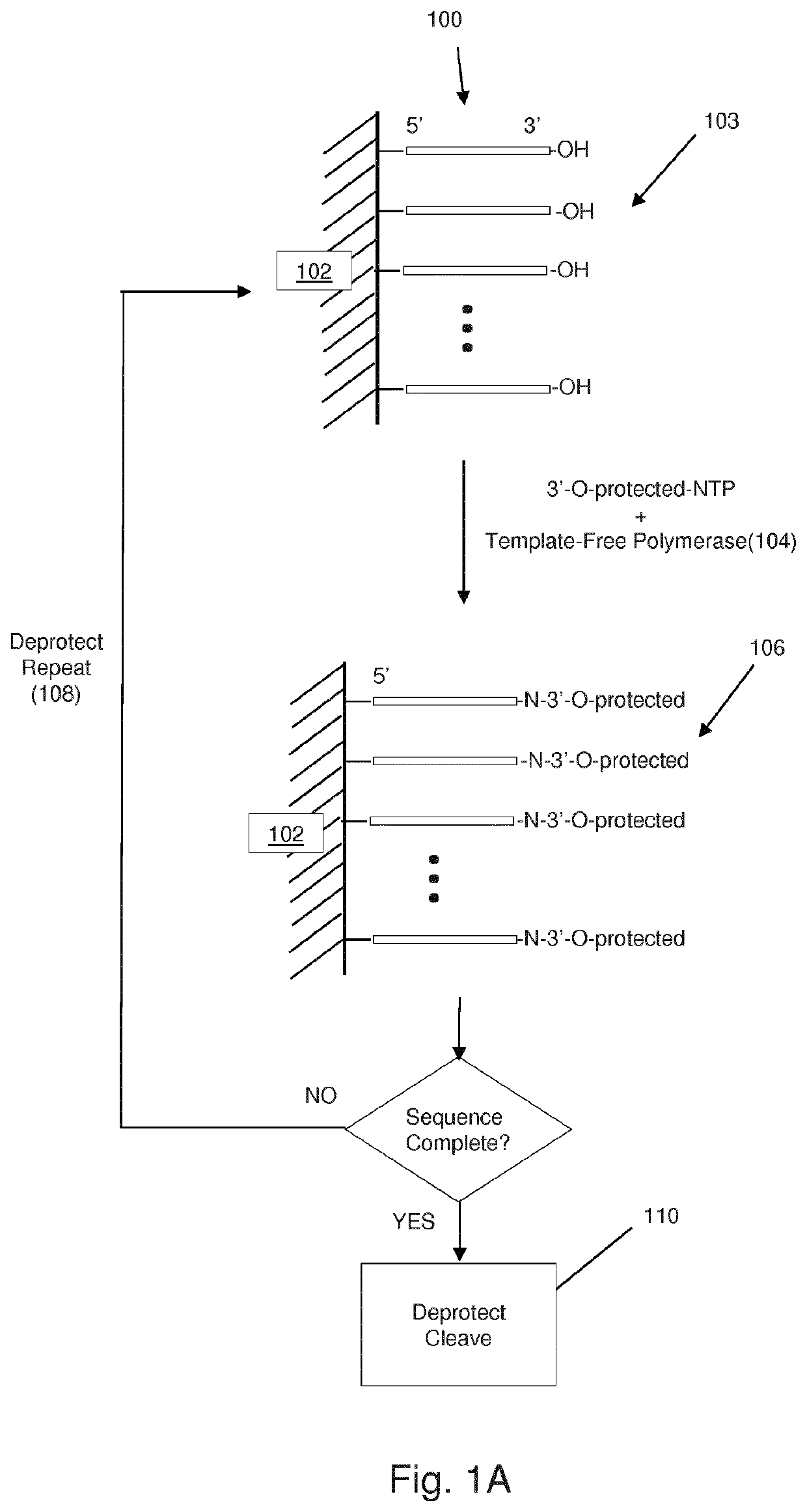Massively Parallel Enzymatic Synthesis of Nucleic Acid Strands
a nucleic acid strand and mass-parallel technology, applied in the field of new, can solve the problems of severely limited adaptation to digital data storage, insufficient throughput to achieve comparable throughput to digital systems, etc., to reduce the likelihood of exonuclease digestion, increase storage life and information integrity, and reduce enzymatic degradation
- Summary
- Abstract
- Description
- Claims
- Application Information
AI Technical Summary
Benefits of technology
Problems solved by technology
Method used
Image
Examples
example 1
Electrochemical Reduction of 3′-O-Azidomethyl-Nucleotide
[0126]In this example, conditions for the reduction of 3′-O-azidomethylnucleotides are determined by applying different voltages across electrodes in microwells for different lengths of time. The treated nucleotides were analyzed by LCMS and gel electrophoresis to determine reaction products.
[0127]Two platinum electrodes were used to apply current to 20 uL aqueous samples (@ 9 mM) of 3′-O-azidomethyldeoxythymidine under 3 and 10 volts for different amounts of time (0, 30, 60 and 300 seconds). Evidence of 3′OH (deprotected) nucleotides in the samples was then assessed with LCMS and gel electrophoresis. Treated nucleotides were used for solution elongation of a primer by a mutant terminal deoxynucleotidyl transferase (SEQ ID NO: 1) that can couple 3′-hydroxyl nucleotides but not 3′-O-azidomethylnucleotides to the primer. The elongation reaction was as follows: 4 uM TdT, 136 uM dTTP (the treated nucleotides from microplate), 10 nm...
example 2
Electrochemical Control of 3′-O-Amino-Nucleotide Deprotection
[0128]An aminoxy reversible protection group on a DNA's 3′ end is cleaved by nitrosium ions (NO+) in acidic conditions, e.g. Benner, U.S. Pat. No. 7,544,794. In this experiment, pH of a deprotection buffer is electrochemically controlled via a quinone / hydroquinone redox system (e.g. Southern et al, U.S. patent publication US2004 / 0238369) to reduce locally pH from an initial value of 7.5 (yielding >0.5% deprotection after 2 minutes) to a final value of 5 (yielding >99% in less than 20 seconds). Results are illustrated in FIG. 9 where pH versus deprotection efficiency for several incubation times.
Definitions
[0129]“Microfluidics device” means an integrated system of one or more chambers, ports, and channels that are interconnected and in fluid communication and designed for carrying out an analytical reaction or process, either alone or in cooperation with an appliance or instrument that provides support functions, such as sa...
PUM
| Property | Measurement | Unit |
|---|---|---|
| Electric potential / voltage | aaaaa | aaaaa |
Abstract
Description
Claims
Application Information
 Login to View More
Login to View More - R&D
- Intellectual Property
- Life Sciences
- Materials
- Tech Scout
- Unparalleled Data Quality
- Higher Quality Content
- 60% Fewer Hallucinations
Browse by: Latest US Patents, China's latest patents, Technical Efficacy Thesaurus, Application Domain, Technology Topic, Popular Technical Reports.
© 2025 PatSnap. All rights reserved.Legal|Privacy policy|Modern Slavery Act Transparency Statement|Sitemap|About US| Contact US: help@patsnap.com



